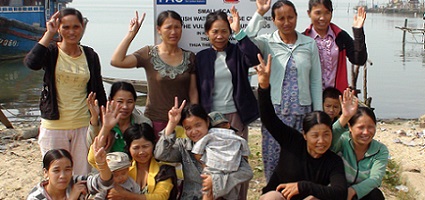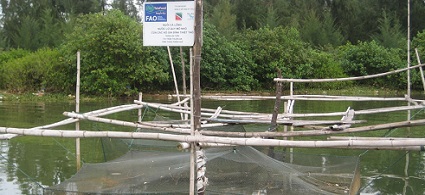Small-scale brackish water fish cage culture with vulnerable households in Hai Tien village, Thuan An town, Thua Thien Hue province

Though small-scale fisheries employ millions of Vietnamese, they struggle to achieve food security. Fish stocks are increasingly depleted because of fishing overcapacity, conflicts over access to fisheries and inadequate fisheries management. Because fishing communities make important but often poorly recognized contributions to the food security and development of many millions of people and to national and regional economies, FAO and Viet Nam are working to improve the sector in a number of areas.
The fisheries project entitled Small-scale brackish water fish cage culture with vulnerable households was implemented in the village of Hai Tien in the coastal town of Thuan An. The target group was the most vulnerable households, especially mothers with children who were rescued from big cities. Because of their low income, many families sent their children to big cities such as Ho Chi Minh to work as cheap labour so they could supplement the family income.
The children were brought back to their families by the non-profit group Blue Dragon and were provided with educational support. However, it was clear that if the income problems of the families were not tackled, these children would again face the risk of being sent back to the cities. FAO developed a Telefood project to increase the income of these poor families by providing the necessary inputs to start cage culture of brackish water fish as a continuous source of income.
The families were predominantly fishing households involved in a mixture of sea and lagoon capture fishing as well as small-scale fish-cage culture, with some existing knowledge and experience in these activities. The project was designed to increase their income and fish productivity by enhancing the small-scale brackish water fish-cage culture.

Starting at the end of 2009, the 12 households participating in the project successfully cultivated brackish water fish in cages with an average output of 145.7 kilograms per family, resulting in additional income of US$584. Out of this amount, on average, US$451 was saved to cover recurring costs for the next crop, depreciation for the fish cage, and contingency money or family savings.
Despite the unusually hot weather in 2010, and challenges such as high prices for fish feed and relatively low prices for cultivated fish, all the project households were able to raise the fish without major fish mortality because of the improved care-taking techniques they learned through the project. They were satisfied with their initial achievement and were highly motivated to continue the fish-cage cultivation to supplement their income.
In addition to extra income and fish to eat, there were some noticeable positive impacts from this small project. The women participating in the project were more respected in the family, especially by their husbands, and the women themselves developed higher self-esteem, a more orderly life and a better environment for their children. The project was highly valued both by local families and Viet Nam’s authorities. It is likely that it will be replicated elsewhere in the country in 2011.
